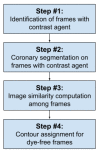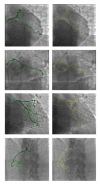CoroFinder: A New Tool for Real Time Detection and Tracking of Coronary Arteries in Contrast-Free Cine-Angiography
- PMID: 35330411
- PMCID: PMC8951569
- DOI: 10.3390/jpm12030411
CoroFinder: A New Tool for Real Time Detection and Tracking of Coronary Arteries in Contrast-Free Cine-Angiography
Abstract
Coronary Angiography (CA) is the standard of reference to diagnose coronary artery disease. Yet, only a portion of the information it conveys is usually used. Quantitative Coronary Angiography (QCA) reliably contributes to improving the measurable assessment of CA. In this work, we developed a new software, CoroFinder, able to automatically identify epicardial coronary arteries and to dynamically track the vessel profile in dye-free frames. The coronary tree is automatically segmented by Frangi's filter in the angiogram's frames where vessels are contrasted ("template frames"). Afterward, the image similarity among each template frame and the dye-free images is scored by cross-correlation. Finally, each dye-free image is associated with the most similar template frame, resulting in an estimation of vessel contour. CoroFinder allows locating the position of coronary arteries in absence of contrast dye. The developed algorithm is robust to diverse vessel curvatures, variation of vessel widths, and the presence of stenoses. This article describes the newly developed CoroFinder algorithm and the associated software and provides an overview of its potential application in research and for translation to the clinic.
Keywords: coronary angiography; coronary artery calcifications; geometric modeling; tracking.
Conflict of interest statement
The authors declare no conflict of interest. The funders had no role in the design of the study; in the collection, analyses, or interpretation of data; in the writing of the manuscript, or in the decision to publish the results.
Figures



Similar articles
-
Automatic centerline extraction of coronary arteries in coronary computed tomographic angiography.Int J Cardiovasc Imaging. 2012 Apr;28(4):921-33. doi: 10.1007/s10554-011-9894-2. Epub 2011 Jun 3. Int J Cardiovasc Imaging. 2012. PMID: 21637981 Free PMC article.
-
Correlation between magnetic resonance angiography (MRA) and quantitative coronary angiography (QCA) in ectatic coronary vessels.J Cardiovasc Magn Reson. 2004;6(1):17-23. doi: 10.1081/jcmr-120027801. J Cardiovasc Magn Reson. 2004. PMID: 15054925
-
Visual and automatic grading of coronary artery stenoses with 64-slice CT angiography in reference to invasive angiography.Eur Radiol. 2007 Jun;17(6):1445-51. doi: 10.1007/s00330-006-0512-y. Epub 2006 Dec 16. Eur Radiol. 2007. PMID: 17180326
-
Current development of cardiac imaging with multidetector-row CT.Eur J Radiol. 2000 Nov;36(2):97-103. doi: 10.1016/s0720-048x(00)00272-2. Eur J Radiol. 2000. PMID: 11116173 Review.
-
Assessment of the vasomotility of epicardial coronary arteries with quantitative coronary angiography.Z Kardiol. 1989;78 Suppl 6:143-8. Z Kardiol. 1989. PMID: 2694662 Review.
Cited by
-
Understanding Vascular Calcification in Chronic Kidney Disease: Pathogenesis and Therapeutic Implications.Int J Mol Sci. 2024 Dec 5;25(23):13096. doi: 10.3390/ijms252313096. Int J Mol Sci. 2024. PMID: 39684805 Free PMC article. Review.
References
-
- Caruso M.V., De Rosa S., Indolfi C., Fragomeni G. Computational analysis of stenosis geometry effects on right coronary hemodynamics; Proceedings of the Annual International Conference of the IEEE Engineering in Medicine and Biology Society; Milan, Italy. 25–29 August 2015; pp. 981–984. - DOI - PubMed
-
- Gaudio L.T., Caruso M.V., De Rosa S., Indolfi C., Fragomeni G. Different Blood Flow Models in Coronary Artery Diseases: Effects on hemodynamic parameters; Proceedings of the Annual International Conference of the IEEE Engineering in Medicine and Biology Society; Honolulu, HI, USA. 18–21 July 2018; pp. 3185–3188. - DOI - PubMed
LinkOut - more resources
Full Text Sources

